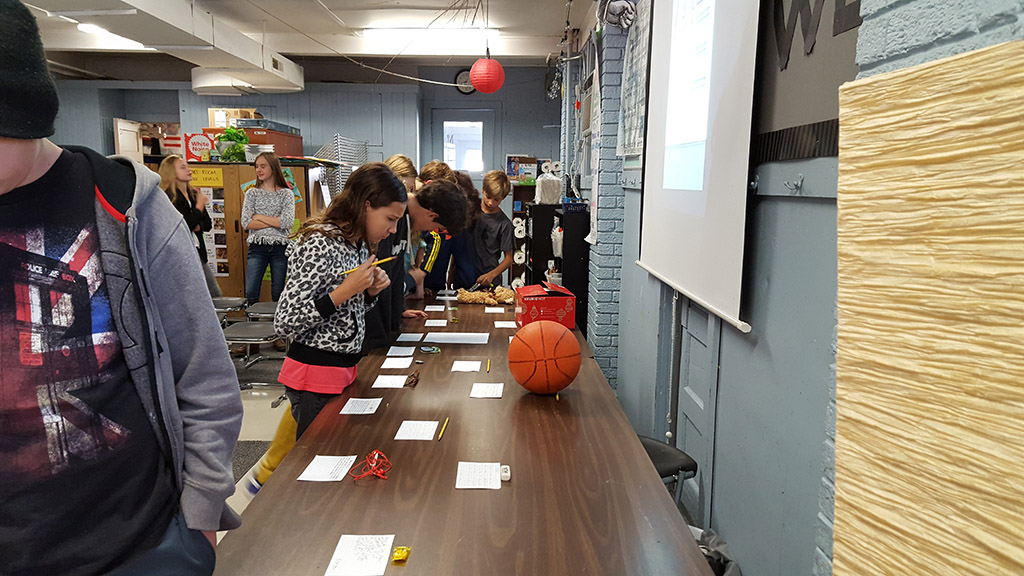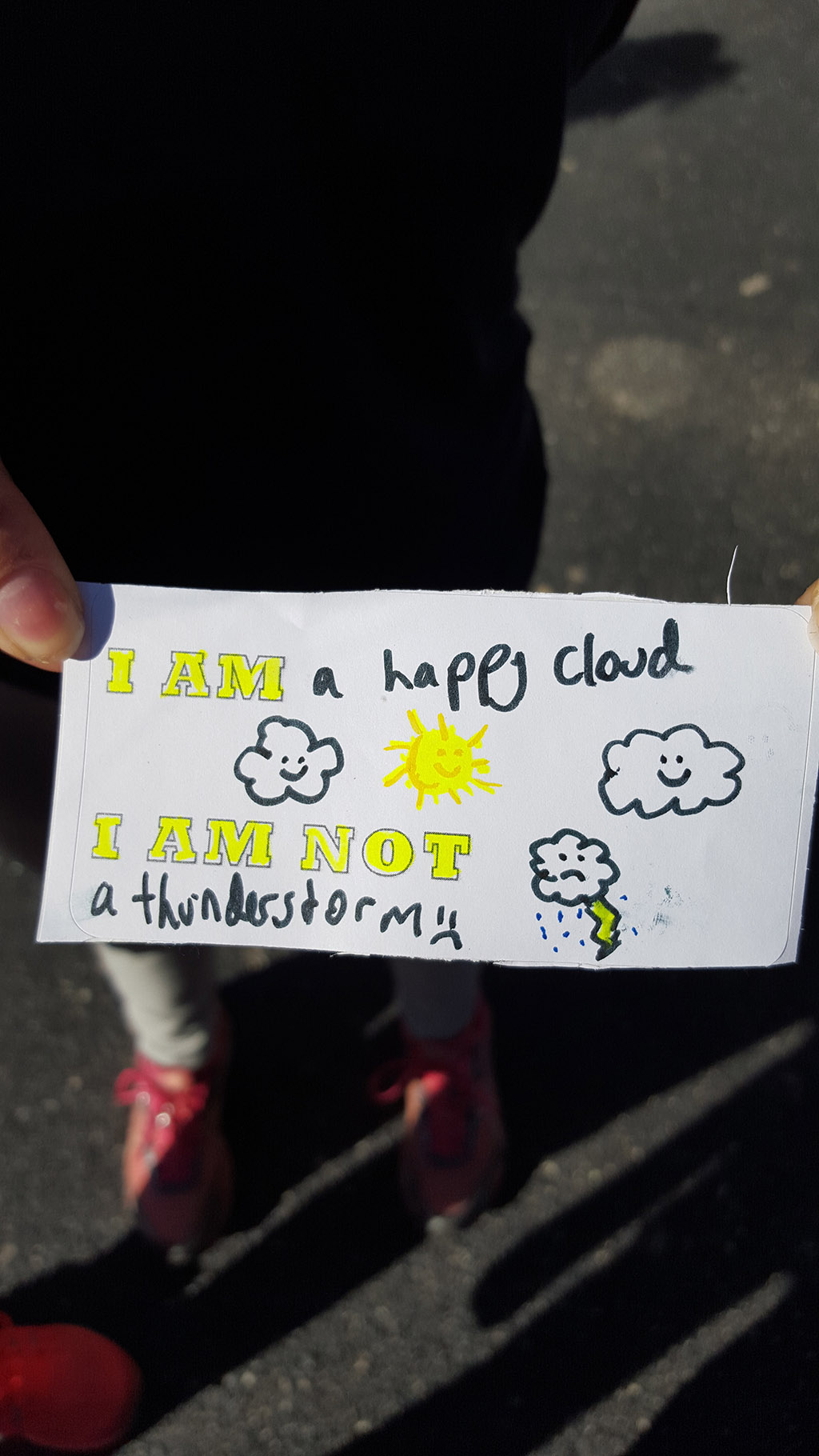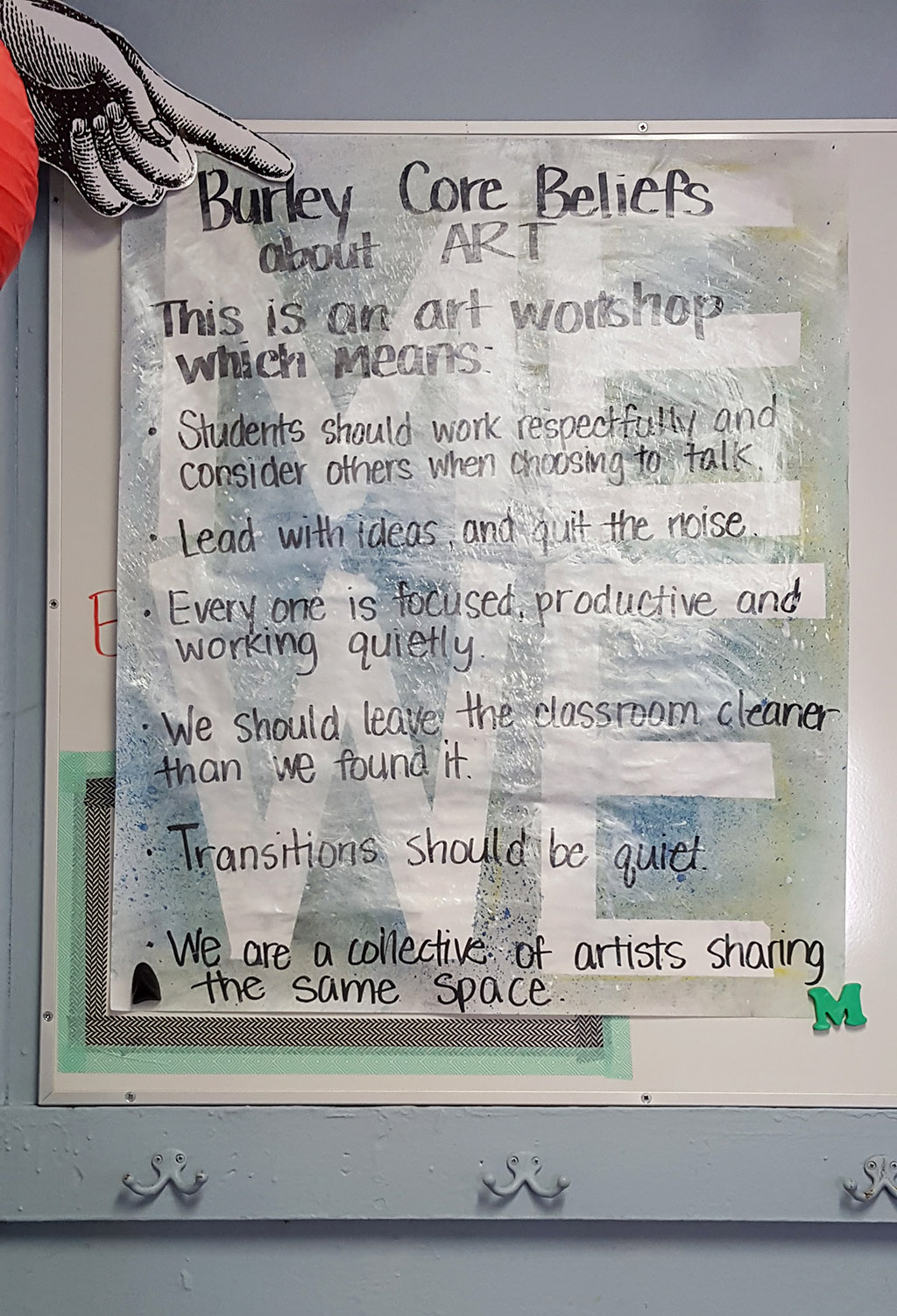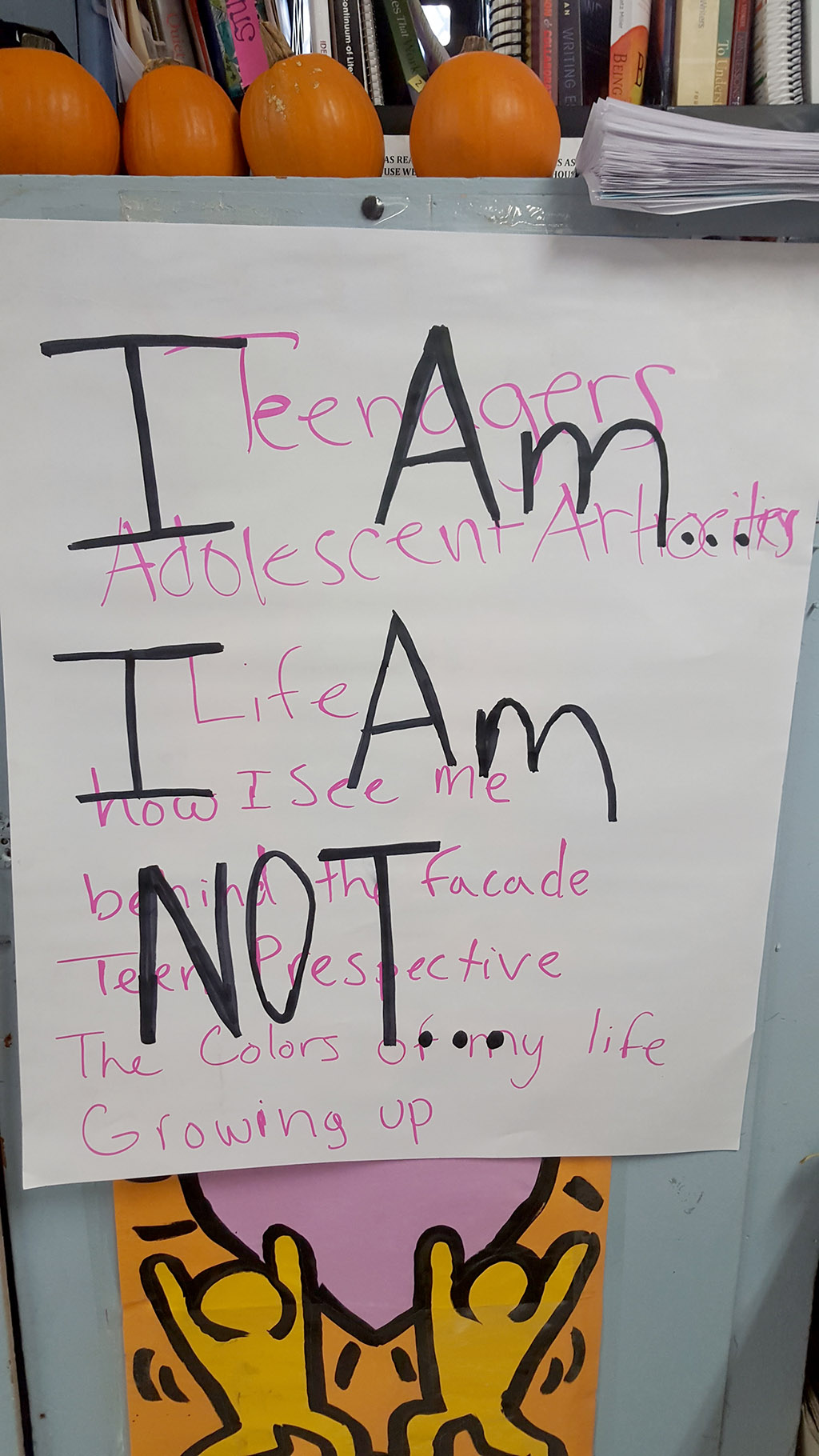I Am I Am Not
By Amy Manata

Through discussion and inquiry, students explored contemporary issues about personal and community identities, learning to collectively create artwork designed to engage the school community. Students investigated contemporary art and how it can be used to interact with a broad audience. Students used their understanding from these experiences to guide the course curriculum and create art based on the common theme of “I am, I am not.”

Goals
Students will understand that:
- Artists can contribute to an awareness and understanding of students’ lives, and the lives of their communities, through art making.
- People develop understandings of society, culture, and history through their interactions with and analysis of art.
- The conditions, attitudes, and behaviors of the community can support innovative thinking, and can also prevent or encourage creative risk-taking.
- Collaboration expands the creative process and produces empathetic awareness, leading to increased appreciation for the self, others, the natural world, and constructed environments.
Objectives
Students will be able to:
- Use discussion and investigation strategies to create socially engaged art.
- Create and use contemporary art to engage with the community.
- Collaborate as a group to develop artworks and curate an art show based on a selected theme.
Guiding Questions
- Do you remember a moment when someone saw a work of art and responded to it?
- What impact does art have on you? How do you react to it?
- How do artists determine what resources are needed to formulate artistic investigations?
- How do artists create works of art that effectively communicate an idea?
- What methods and processes are considered when preparing artwork for presentation or preservation?

Documentation + Assessment
The students used writing and photography to record and reflect upon their process. For their final reflection, the students wrote about what they thought socially engaged art was, how they created socially engaged art, and where they could use socially engaged art in their own lives. During the ongoing documentation process, some students took the project one step further and created an impromptu interview video. In this video, students took turns sharing their thoughts on their personal and group identities. The students and instructor evaluated the success of the projects using a rubric designed to assess both development and execution.
Timeframe + Learning Activities
- Students experienced the artwork Give us a Poem by Glenn Ligon. The students used this artwork’s theme—the individual vs. the collective—as an entry point to create a class contract about the shared space of the art classroom.
- Then students viewed the “What is Contemporary Art?” PowerPoint presentation. We discussed the qualities of contemporary art and how it can open up a conversation about social issues.
- Together, the class curated a pop–up art exhibit of found objects representing identity, based on the theme “I see something that you don’t see.” The students brought in found objects representing “self.” These were objects that at first can be construed as ordinary, but take on a whole new meaning when viewed in terms of identity. The students created museum labels for the objects. We displayed the objects and cards on tables and invited students to walk through and experience the exhibition. The students were very connected to this experience and gained a better understanding of how everyday objects can take on greater or different meanings when placed in different contexts. We saw how this change of context can spark meaningful discussion.
- Our class took a field trip to the Museum of Contemporary Art to experience the Freedom Principle exhibition, which focused on collectivity in artmaking.
- Afterwards, we had a field trip debriefing. We generated a list of issues that the students thought were relevant and meaningful to their own lives and to the lives of people in the larger community. We examined the list, identifying similar themes, and students worked together to define an idea for their art making. The students collectively decided upon the theme of “I AM … I AM NOT,” which addressed self-identity and stereotypes.
- The students spent the next several class periods working individually and in groups, creating artwork based on their understandings of the theme of “I AM … I AM NOT.” The students were able to use found objects, traditional materials, video, and sound to create these artworks, addressing the complexity of individual and group identities. One group of students created a video about female stereotypes and the idea of “Girl Power.” Another group created sound recordings about the unkind words people call each other. Other students made a giant mural using post-it-note responses to the theme, gathered from the entire school.
- One of the groups of students created stickers that said “I am ____I am not_____,” with blank spaces for project participants to complete the sentence. They shared the stickers with the entire school, so that for one day, everyone was engaged in their project. Some of the conversations that came up were: “I am a girl, I am not weak,” and “I am worthy, I am not just what you see.” This project became a catalyst for conversations about stereotypes and making assumptions. It was a major highlight of the students’ investigation of working as a collective, as this project brought our art making actions beyond the classroom and engaged the whole school community.
- On our presentation day, students presented their artwork, videos, and recordings to the entire class. Students reflected on the challenges they encountered when working collectively, and talked about how they might approach the process differently moving forward.
- We created an art show: the artwork was displayed during report card pick-up, when the parents and larger school community were able to experience it. As part of this display, the students engaged the visitors with their “I am ____I am not_____” stickers, asking the visitors to complete the stickers and share the reasons for their statements. This interactive component was interesting for the adult community, because they weren’t able to just walk around and say “ooh and ah” as they looked at static artworks. Instead, they connected with the students and had conversations about stereotypes and making judgements. Several adults commented, “Wow, I didn’t know that about you.”

Materials
- Found / recycled objects
- Art making materials
- iPads
- Computers
MCA Connections
The use of “ME / WE” concepts regarding self-identity and stereotypes in my classroom, inspired by Glenn Ligon's Give us a Poem, gave the students a connection to the MCA before ever arriving to the museum. Once we arrived at the MCA, the students were instantly able to connect The Freedom Principle exhibit and its socially engaged message with our collective work and dialogue in the classroom. They were able to gain a deeper understanding of contemporary art, seeing how investigating the concepts addressed in contemporary artworks can provide a space for meaningful discussion about life, beliefs, and relationships that extend beyond the physical artworks. The conversations that they had with MCA Artist Guides helped students formulate their own ideas about socially engaged art. At one point, the students sat on cube seats created by artist John Preus, using recycled school furniture from 50 closed Chicago schools. The history of these seats helped the students better understand how contemporary art can tell a story about social issues connected to the needs of a specific community. The cubes prompted a group discussion that helped the students see the impact of the closed schools and understand how learning in those closed schools was disrupted. When the students returned to our classroom, they better understood that contemporary art wasn’t just art to look at, but art with a message worth discussing.

References + Resources
- Naomi Beckwith and Dieter Roelstraete, eds., The Freedom Principle: Experiments in Art and Music, 1965 to Now (Chicago: University of Chicago Press, 2015).
- MCA's 'Freedom Principle' Highlights Experimentation in 1960s Chicago
Amy Manata
Burley Elementary
Amy Manata has spent 21 years teaching. This is her 19th year teaching elementary K-8 art in Chicago Public Schools. Amy has taught in the Back of the Yards neighborhood, in Avondale, and is currently teaching at Burley Elementary school in Lakeview. She attended Columbia College Chicago for her undergraduate studies, and National Louis University for graduate school. Amy believes that art is work, not magic. But it can be magical. Creation is the highest level of learning—art is the thread that links all the academic subjects to our own personal lives. Art enhances other subjects and at the same time stands alone as a unique and irreplaceable learning experience. Amy draws inspiration from her students every single day.
Amy reflects on her process:
This project was transformative for both the students and teacher. The students embraced the challenge to work collectively and create socially engaged artwork that addressed the issues of self-identity and stereotypes within their school community. They were the driving force and facilitators behind developing the project, ultimately arriving at the theme of I AM I AM NOT. Their ideas, concerns, and experiences guided the conversations, thinking, and language. The students expanded the project beyond the classroom on their own through their sticker performance project, engaging the members of the school community in the discussions that began in the classroom.
The biggest hallelujah moment for me was when this project went in a completely different direction than I had originally envisioned. I had wanted our artistic investigation to follow a particular plan, but the students just weren’t buying it. When I finally let go and listened to their voices, it was like magic. As they developed and implemented the “ME WE” performance project, they took complete control and were more engaged than I had ever seen them before. The biggest obstacle of this project was the length of time that it took, because this class met only once a week. I was able to address it by playing a video clip of Give Us a Poem by Glenn Ligon and the song Everyday People by Sly and the Family Stone each week as they walked in, to help bring them back to the place where they had left off and to reconnect the individual students to the powerful work they were engaging in as a group.